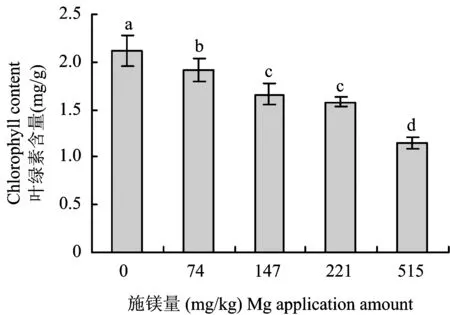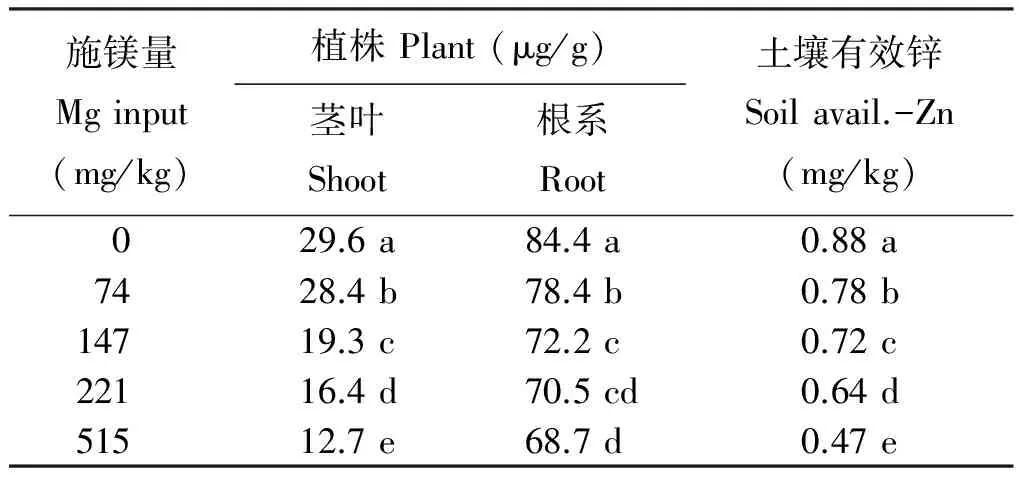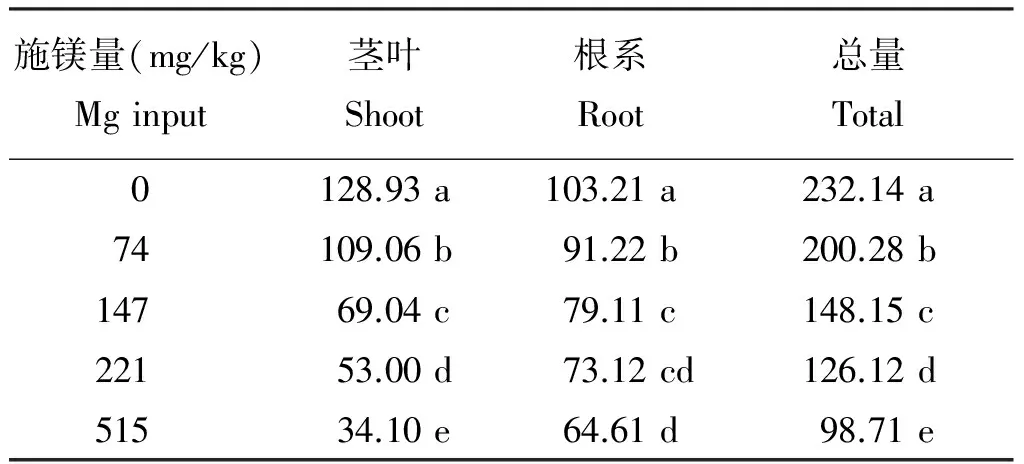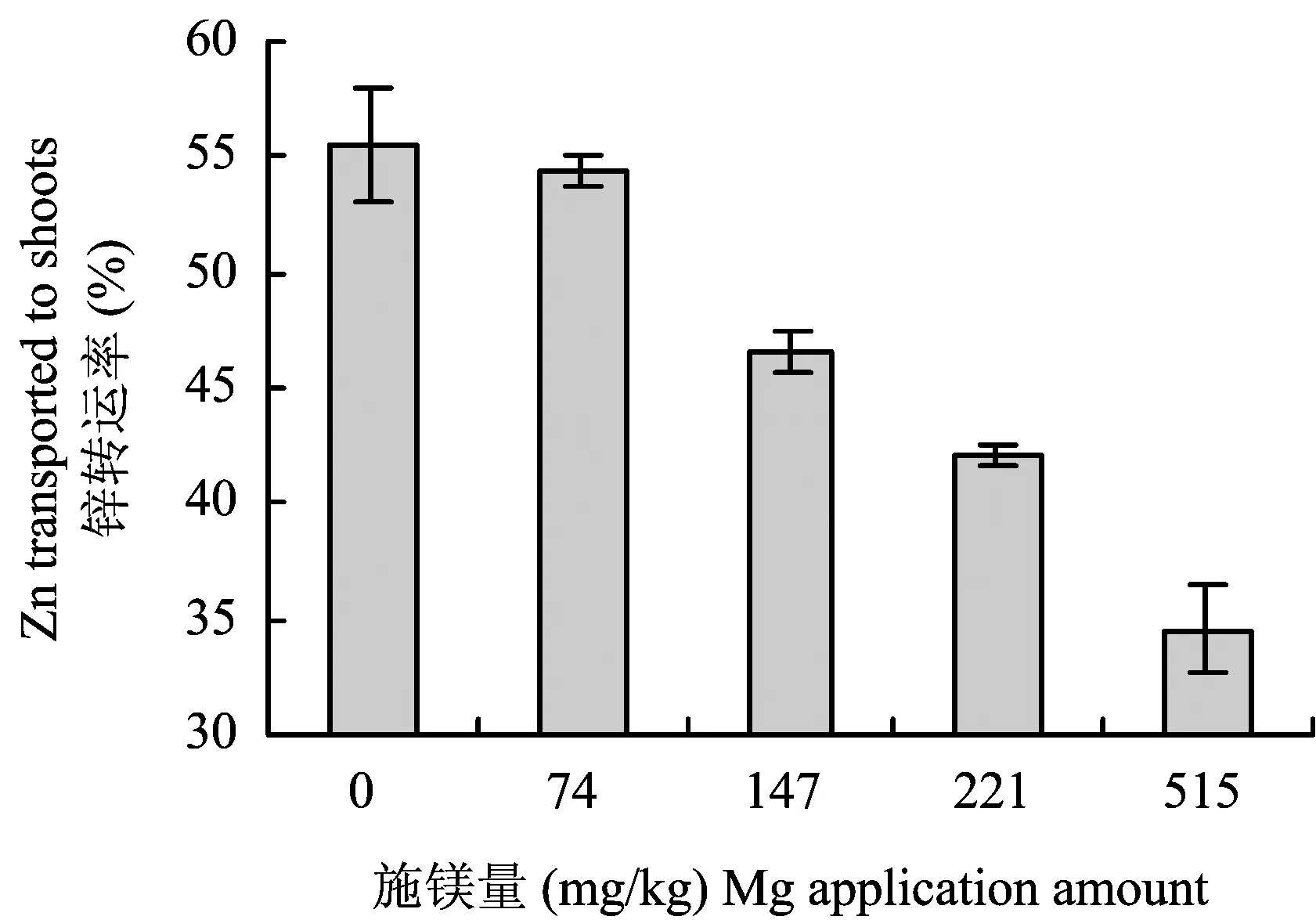绿洲盐化潮土施镁对玉米幼苗生长、活性氧自由基代谢和锌营养的影响
杨思存, 霍 琳, 王成宝, 姜万礼
(甘肃省农业科学院土壤肥料与节水农业研究所, 农业部甘肃耕地保育与农业环境科学观测实验站, 兰州 730070)
绿洲盐化潮土施镁对玉米幼苗生长、活性氧自由基代谢和锌营养的影响
杨思存, 霍 琳, 王成宝, 姜万礼
(甘肃省农业科学院土壤肥料与节水农业研究所, 农业部甘肃耕地保育与农业环境科学观测实验站, 兰州 730070)

盐化潮土; 土壤交换镁; 锌营养; 活性氧自由基代谢; 玉米幼苗


1 材料与方法
1.1 试验材料

1.2 试验设计
试验采用盆栽方法,供试盆钵为塑料盆,高30 cm、直径20 cm,将土壤和肥料均匀混合后装盆,每盆装风干土5 kg。以硫酸镁为镁源,设加入镁(Mg)0、74、147、221、515 mg/kg 5个水平,混合后,土壤交换性Mg含量分别为287.3、349.2、411.6、487.9和755.2 mg/kg,依次代表绿洲盐化潮土含镁量低、较低、中等、较高、极高5种类型。除试验设计镁用量外,每个处理施N 100 mg/kg、P 50 mg/kg和K 63 mg/kg。所施肥料均以溶液形式施入,充分与土壤混匀后灌水至饱和,平衡1天后播种。玉米经催芽于4月20日播种,每盆8粒,7 d后定苗,每盆5株。玉米生长期间浇灌去离子水,用重量法控制水分供应。各处理均重复6次。玉米生长到6叶期时(45 d)收获,测定株高后,其中3次重复采集心叶下第二个叶片鲜样用于测定叶绿素含量,超氧化物歧化酶(SOD)、过氧化物酶(POD)、过氧化氢酶(CAT)活性和丙二醛(MDA)含量。另外3次重复分为地上部茎叶和地下部根系两部分收获,洗净后先在90℃下杀青30 min,再在60℃下烘干至恒重,分别称重后用不锈钢粉碎机粉碎,过0.25 mm筛备用。同时采集土壤样品,自然风干、磨碎后过1 mm筛备用。
1.3 测定项目与方法

叶片叶绿素含量测定采用丙酮浸提分光光度法,超氧化物歧化酶(SOD)活性测定采用氮蓝四唑(NBT)法,过氧化物酶(POD)活性测定采用愈创木酚法,过氧化氢酶(CAT)活性测定采用高锰酸钾滴定法,丙二醛(MDA)含量测定采用硫代巴比妥酸法,具体方法参照文献[16]。
1.4 统计分析
采用Excel 2003和SAS 9.0软件对数据进行统计分析,LSD法检验差异显著性。
2 结果与分析
2.1 施镁对玉米幼苗生长的影响


表1 不同施镁水平玉米株高和干物质产量
注(Note): 同列数据后不同字母表示处理间差异达5%显著水平 Values followed by different letters in a column are significantly among treatments at the 5% leve1.
2.2 施镁对玉米叶片叶绿素含量和活性氧自由基代谢的影响

图1 不同施镁量玉米幼苗叶绿素含量Fig.1 Chlorophyyll contents of maize seendling under different Mg application amount[注(Note): 方柱上不同字母表示处理间差异达5%显著水平 Different letters above the bars mean significant among treatments at the 5% level.]
2.2.1 叶绿素含量 随着施镁量的增加或土壤含镁量水平的提高,玉米叶片叶绿素含量显著下降(图1)。与不施镁处理相比,施镁74、147、221、515 mg/kg处理的叶绿素含量分别降低了9.4%、21.6%、25.4%和45.9%,特别是在土壤施镁量达到515 mg/kg时,叶绿素含量几乎降低了一半,导致玉米叶片枯黄,出现明显的镁中毒现象和典型缺锌症状。
2.2.2 活性氧自由基代谢 随着施镁量的增加或土壤含镁量水平的提高,玉米幼苗叶片中SOD、POD、CAT活性的变化趋势基本一致,三者都是先升高再迅速降低(表2)。SOD和CAT活性的峰值均出现在施镁量147 mg/kg,施镁74、147 mg/kg处理分别比不施镁处理增加9.93%、13.54%和13.06%、23.31%,施镁221、515 mg/kg处理分别比不施镁处理降低19.24%、49.75%和0.51%、32.21%;POD活性的峰值出现在施镁量74 mg/kg,但与不施镁处理差异不显著;施镁221、515 mg/kg处理分别比不施镁处理降低了20.93%和48.06%。这说明在适量施镁范围内,3种保护酶能起到协同作用,提高保护酶活性,减轻活性氧自由基对膜脂的毒害,从而起到保护植物的作用;但当施镁量或土壤含镁量超出正常范围后,就会对保护酶活性造成伤害。
丙二醛(MDA)是自由基对细胞膜脂进行过氧化伤害的最终产物之一,其含量变化可代表细胞的脂质过氧化水平和生物膜损伤程度的大小,是判断膜脂过氧化作用的一个重要指标[17]。由表2可以看出,随着施镁量的增加或土壤含镁量水平的提高,玉米幼苗叶片中MDA含量始终呈增加趋势。与不施镁处理相比,施镁74、147、221、515 mg/kg处理分别增加了20.39%、66.74%、102.71%和183.58%。说明高镁胁迫能增强脂质过氧化作用,造成MDA在玉米叶片中大量积累。

表2 不同施镁量玉米幼苗SOD、POD、CAT活性和MDA含量
注(Note): 同列数据后不同字母表示处理间差异达5%显著水平 Values followed by different letters in a column are significantly among treatments at the 5% leve1.
2.3 施镁对玉米锌含量的影响
2.3.1 土壤及玉米的锌含量 施镁显著降低了玉米幼苗的Zn含量(表3),与不施镁相比,茎叶的Zn含量分别降低了4.05%、34.80%、44.59%和57.09%,根系的Zn含量分别降低了7.55%、14.90%、16.82%和18.99%。可以看出,根系Zn含量的降低幅度明显低于茎叶,之所以出现这种差异,一方面与茎叶和根系对锌吸收能力的不同有关;另一方面也可能与锌的转运受阻有关。


表3 不同施镁量下玉米幼苗及土壤有效锌含量
注(Note): 同列数据后不同字母表示处理间差异达5%显著水平 Values followed by different letters in a column are significantly among treatments at the 5% leve1.
2.3.2 玉米的锌吸收量 与Zn含量相似,施镁也显著降低了玉米幼苗的Zn吸收量(表4),与不施镁相比,茎叶的Zn吸收量分别降低了15.41%、46.45%、58.89%和73.55%,根系的Zn吸收量分别降低了11.62%、23.35%、29.16%和37.40%,植株总体Zn吸收量分别降低了13.73%、36.18%、45.67%和57.48%。可以看出,根系吸收量的降低幅度明显低于茎叶,说明施镁虽然抑制了Zn的吸收量,但对茎叶和根系的抑制程度不同,仍有一部分Zn累积到了根系而没有向地上部转运。

表4 不同处理玉米幼苗锌的吸收量(μg/plant)
注(Note): 同列数据后不同字母表示处理间差异达5%显著水平 Values followed by different letters in a column are significantly among treatments at the 5% leve1.
2.3.3 Zn从根系向地上部的转运 Rengel等[18]将养分的转运率定义为植株地上部养分的吸收量与整株吸收量的比值。在本研究中,我们对不同施镁条件下玉米幼苗的Zn转运情况进行了分析。从图2可以看出,随着施镁量的增加或土壤交换态镁含量的提高,Zn从根系向地上部的转运显著降低,施镁147 mg/kg,土壤交换性镁含量为411.6 mg/kg时,Zn的转运率还有46.60%,施镁515 mg/kg,土壤交换性镁含量为755.2 mg/kg时只有34.55%,仅达到不施镁水平的62%,表明施镁或高土壤交换性镁对地上部茎叶的抑制作用较根系更为明显(表1),导致根系累积了更多的锌的缘故;对Zn含量和Zn吸收量的分析也有相同的结论(表3、表4)。

图2 施镁对玉米幼苗锌转运的影响 Fig.2 Effects of Mg applied in soil on Zn transported to shoots of maize plants
3 讨论
3.1 高镁土壤对作物生长发育的影响

3.2 高镁环境对土壤Zn有效性的影响

3.3 高镁环境对Zn吸收转运的影响
锌在植物体内以自由离子状态存在或与各种低分子化合物配合,其吸收和转运受多种因素制约,其中供锌水平和离子间的交互作用是植物营养学家研究较多的问题。大量研究结果表明,缺锌条件下作物体内锌浓度显著下降,施锌能大幅度提高作物体内锌含量和累积量[29-31]。本研究是在潜在缺锌的石灰性土壤上进行,有效锌含量(DTPA-Zn)只有0.89 mg/kg,土壤供锌水平很低,因此不同处理玉米体内锌含量和吸收量都很低。芦满济[5]等认为镁与锌之间存在拮抗作用,Zn的生物毒性试验也证明Mg2+可以减少Zn的毒害作用[32],本研究中随着施镁量的增加,土壤和作物根际Mg2+含量都大幅度增加,充足的Mg2+充分满足了作物对镁素营养的需求,但对于玉米幼苗的锌营养来说,其作用是相反的,高浓度的Mg2+有可能在质外体交换位点上与Zn2+产生竞争[33],从而造成玉米茎叶和根系中的锌含量、锌吸收量都显著降低,这与上述研究者的结论是一致的。另外,本研究中施镁221 mg/kg时,玉米茎叶含锌量为16.4 μg/g,已表现出缺锌胁迫;施镁515 mg/kg时,茎叶含锌量只有12.7 μg/g,表现出缺锌症状,这与大多数研究者所认同的作物潜在性缺锌和缺锌临界值(茎叶含锌量<20 mg/kg和15 mg/kg)是一致的[13]。本研究中随着施镁量的增加,Zn从根系向地上部的转运显著降低,这一方面与施镁对茎叶和根系的抑制程度不同有关(表1),另一方面也可能与环境中大量存在的Mg2+离子抢先占据了转运蛋白上的有利位置,导致根系吸收的锌不能向地上部运输有关[34]。
4 结论
1)绿洲盐化潮土上的玉米缺锌问题与土壤含镁量水平密切相关,随着施镁量的增加,玉米幼苗的生长受到抑制,达到515 mg/kg时表现出明显的镁中毒症状和典型缺锌症状,株高、干重、叶片中的叶绿素含量和SOD、POD、CAT活性都显著降低,MDA含量显著增加。
2)施镁抑制了玉米幼苗对锌的吸收,但对茎叶的抑制程度明显高于根系,导致玉米根系的锌含量和吸收量都普遍高于茎叶,锌从根系向地上部的转运率显著降低,施镁515 mg/kg时只有34.55%,仅达到不施镁水平的62%。
3)施镁降低了土壤有效锌含量,用量达到515 mg/kg时,土壤有效锌含量已降至0.47 mg/kg,超过了土壤缺锌临界值(DTPA-Zn<0.5 mg/kg)。
[1] 李加宏, 俞仁培. 镁质盐渍土危害作物生长机理的初步研究[J]. 土壤通报, 1997, 28(6): 246-247. Li J H, Yu R P. The preliminary study on Mg-saline soil to against the growth mechanism of crops[J]. Chinese Journal of Soil Science, 1997, 28(6): 246-247.
[2] 田兆顺, 董汉章. 河西走廊镁质碱化盐渍土的初步研究[J]. 土壤, 1977, 233-240. Tian Z S, Dong H Z. The preliminary study on Mg-alkalization saline soil of Hexi Corridor[J]. Soils, 1977, 233-240.
[3] 刘向来. 镁质碱化土的改良[J].土壤通报, 1985, 16(2): 62-63. Liu X L.Reclamation for Mg-alkalization soil[J].Chinese Journal of Soil Science, 1985, 16(2): 62-63.
[4] 芦满济, 祁国元, 杨思存, 等.绿洲盐化潮土的锌肥效应及适宜用量[J].西北农业学报, 1999, 8(1): 69-73. Lu M J, Qi G Y, Yang S Cetal.The effect of chemical zinc and it’s optimum rate on maize in saline fIuvo-aquic soil of Hexi oasis area[J].Acta Agriculturae Boreali-Occidentalis Sinica, 1999. 8(1): 69-73.
[5] 芦满济, 祁国元, 杨思存.土壤盐分对土壤植物锌营养和施锌效果的影响[A]. 李生秀. 土壤—植物营养研究文集[C]. 陕西科学技术出版社, 1999. 746-52. Lu M J, Qi G Y, Yang S C. Effects of soil salt and Zn application on Zn nutrition of soil and plant[A]. Li S X. Nutrition research of plant and soil [C]. Shaanxi Science and Technology Press, 1999.746-752.
[6] 陆景陵. 植物营养学(上册)(第2版)[M]. 北京: 中国农业大学出版社, 2003. 69-73. Lu J L. Plant nutrition (Ⅰ) (2rd Ed)[M]. Beijing: China Agricultural University Press, 2003. 69-73.
[7] Hajiboland R, Yang X E, Romheld. Effects of bicarbonate and high pH on growth of Zn-efficient and Zn-inefficient genotypes of rice, wheat and rye[J]. Plant and Soil, 2003, 250: 349-357.
[8] 刘铮. 我国土壤中锌含量的分布规律[J]. 中国农业科学, 1994, 27(1): 30-37. Liu Z. Regularities of content and distribution of zinc in soils of China[J]. Scientia Agricultura Sinica, 1994, 27(1): 30- 37.
[9] 胡明芳, 文启凯, 田长彦. 作物锌素营养研究进展与展望[J]. 新疆农业科学, 1997, (5): 214-216. Hu M F, Wen Q K, Tian C Y. The progress and prospects of zinc nutrition in crops[J]. Xinjiang Agricultural Sciences, 1997, (5): 214-216.
[10] Barber S A. Soil nutrient bioavailability[M]. New York: Jones Wiley and Sons, Inc. 1984.
[11] Marschner H. Zinc uptake from soil[A]. Robson A D. Zinc in soils and plants[C]. Dordrecht: Kluwer Academic Publishers, 1993. 59-77.
[12] Curtin D, Smillie G. Soil solution composition as affected by liming and incubation[J]. Soil Science Society of American Journal, 1983, 47(4): 701-707.
[13] 孙桂芳, 杨光穗. 土壤一植物系统中锌的研究进展[J]. 华南热带农业大学学报, 2002, 8(2): 22-30. Sun G F, Yang G S. The prospect of zinc in soil and plant system[J]. Journal of South China University of Tropical Agriculture, 2002, 8(2): 22-30.
[14] Shula L M, Rathan P K. Zinc magnesium interactions in soil and plants as measured by crop response[J]. International Journal of Trogical Agriculture, 1983,1: 309- 316.
[15] 鲁如坤. 土壤农业化学分析方法[M]. 北京: 中国农业科技出版社, 1999. Lu R K. Analytical methods of soil and agricultural chemistry[M]. Beijing: China Agricultural Science and Technology Press, 1999.
[16] 李合生. 植物生理生化实验原理和技术[M]. 北京: 高等教育出版社, 2000. 182-185. Li H S. Experimental principle and technique for plant physiology and biochemistry[M]. Beijing: Higher Education Press, 2000. 182-185.
[17] Tang T, Shi S, Li Detal. Physiological and biochemical responses ofScytonemajavanicum(cyanobacterium)to salt stress[J].Journal of Arid Environments, 2007, 71(3): 312- 320.
[18] Rengel Z, Graham R D.Wheat genotypes differ in Zn efficiency when grown in chelate-buffered nutrient solution Ⅱ. Nutrient uptake[J]. Plant and Soil, 1995, 176: 317-324.
[19] 汪洪, 褚天铎. 植物镁素营养的研究进展[J]. 植物学通报, 1999, 16(3): 245-250. Wang H, Chu T D. The progress of study on mechanism nutrition in plants[J]. Chinese Bulletin of Botany, 1999, 16(3): 245-250.
[20] 王芳, 刘鹏, 徐根娣. 土壤中的镁及其有效性研究概述[J]. 河南农业科学, 2004, (1): 33-36. Wang F, Liu P, Xu G D. The review for Magnesium and it’s availability research in soil[J]. Journal of Henan Agricultural Sciences, 2004, (1): 33-36.
[21] Narwal R P, Kumar V, Singh J P. Potassium and magnesium relationship in cowpea[J]. Plant and Soil, 1985, 86: 129-134.
[22] Chitralekha C, Nirmala N. Influence of changes in manganese and magnesium supply on some aspects of wheat physiology[J]. Soil Science and Plant Nutrition, 1994, 40(2): 191-197.
[23] Portis A R Jr. Evidence of a low stromal Mg2+concentration in intact chloroplasts in the dark[J]. Plant Physiol, 1981, 67(5): 985-989.
[24] Duguid J G, Bloomfied V A. Aggregation of melted DNA by divalent metal ion-mediated cross-linking[J]. Biophysical Journal, 1995, 69(6): 2642-2648.
[25] 汪洪, 褚天铎. 缺镁对菜豆幼苗膜脂过氧化及体内活性氧清除酶系统的影响[J]. 植物营养与肥料学报, 1998, 4(4): 386-392. Wang H, Chu T D. Effect of Mg deficiency on plasma membrane permeability, membrane lipid peroxidation and endogenous oxygen radicals scavenging enzymes systems in common bean[J]. Plant Nutrition and Fertilizer Science, 1998, 4(4): 386-392.
[26] 钱红, 谢振翅. 碳酸盐对土壤锌解吸影响的研究[J]. 土壤学报, 1994, 31(1): 105- 108. Qian H, Xie Z C. Effect of carbonate on desorption of soil zinc[J]. Acta Pedologica Sinica, 1994, 31(1): 105- 108.
[27] 刘铮, 朱其清. 微量元素的农业化学[M]. 北京: 农业出版社, 1991. Liu Z, Zhu Q Q. Agrochemistry of microelements[M]. Beijing: Agriculture Press, 1991.
[28] 谢正苗. 土壤中锌的化学平衡[J]. 环境科学进展, 1996, 4(5): 13-30. Xie Z M. Chemical equilibria if zinc in soils[J]. Advances in Environmental Science, 1996, 4(5): 13-30.
[29] 王景安, 张福锁. 供锌水平对玉米幼苗生长发育及锌含量的影响[J]. 吉林农业大学学报, 2000, 22 (1): 69- 72. Wang J A, Zhang F S. The effect of supplying different levels of Zn on the growth and Zn concentration of maize seedling[J]. Journal of Jilin Agricultural University, 2000, 22 (1): 69- 72.
[30] 汪洪, 周卫, 金继运. 分层供水和表层施锌对玉米植株生长和锌吸收的影响[J]. 中国土壤与肥料, 2007, (4): 63-67. Wang H, Zhou W, Jin J Y. Maize plant growth, root biomass distribution, and zinc uptake as affected by Zn application and different water conditions in soil layers[J]. Soil and Fertilizer Sciences in China, 2007, (4): 63-67.
[31] 陆欣春, 陈玲, 田霄鸿, 等. 供锌条件下碳酸钙对小麦幼苗生长和锌吸收的影响[J]. 应用生态学报, 2006, 17(8): 1424- 1428. Lu X C, Chen L, Tian X Hetal. Effects of CaCO3addition under Zn supply on wheat seedlings growth and Zn uptake[J]. Chinese Journal of Applied Ecology, 2006, 17(8): 1424- 1428.
[32] Jansen S, Blust R, Van Leeuwen H P. Metal speciation dynamics and bioavailability: Zn (Ⅱ) and Cd (Ⅱ)uptake by mussel (Mytilusedulis)and carp (Cyprinuscarpio)[J]. Environment Science & Technology, 2002, 36(10): 2164-2170.
[33] Campbell P G C. Interactions between trace metals and aquatic organisms: A critique of free ion activity model[A]. Tessier A, Tunner D R. Metal Speciation and bioavailability in aquatic systems[M]. New York, USA: John Wiley, 1995. 45- 97.
[34] Hanikenne M, Kramer U, Demoulin Vetal. A comparative inventory of metal transporters in the green algaChlamydomonasreinhardtiiand the red algacyanidioschizonmeralae[J]. Plant Physiology, 2005, 137: 428- 446.
Inhibition of high Mg concentration on seedling growth, free radical metabolism of reactive oxygen and zinc nutrition of maize in saline fluvo-aquic soils
YANG Si-cun, HUO Lin, WANG Cheng-bao, JIANG Wan-li
(InstituteofSoil,FertilizerandWater-savingAgriculture,GansuAcademyofAgriculturalSciences/GansuScientificObservingandExperimentStationofAgro-EnvironmentandArableLandConservation,MinistryofAgriculture,Lanzhou730070,China)
【Objectives】 Zinc deficiency is very often happened in maize in saline fluvo-aquic soils in Hexi Oasis Area of Gansu Province, the high soil magnesium levels have been regarded as a major contributor to this deficiency. The inhibition effect of magnesium to zinc in saline fluvo-aquic soils in Hexi Oasis Area were discussed in this paper. 【Methods】 A pot experiment was conducted with maize as materials. Exchangeable magnesium contents of 287.3, 349.2, 411.6, 487.9 and 755.2 mg/kg were obtained by irrigating different amount of MgSO4solution. The maize plants were harvested at 46 days, the biomass of above and under ground parts were dried and weighed, the Zn contents were measured. The second leaf under the interior leaf was used for the determination of active oxygen and some enzyme activities. 【Results】 1)More high and extremely high exchangeable Mg level in soil inhibits the growth of maize seedlings. When magnesia applied levels is 221 mg/kg, i.e. the exchangeable Mg content in soil is over 487.9 mg/kg, the growth of maize is stressed, when the Mg2+applied level is 515 mg/kg, i.e. the exchangeable Mg content in soil is over 755.2 mg/kg, the plant height is markedly decreased by 14.5%, showing symptoms of magnesia poison and zinc deficiency, such as withered leaf margins and partial white stripes on the leaves (P<0.01). 2)With the increase of or exchangeable Mg levels, the dry weight in the of Mg2+addition maize are reduced by 11.9%-38.3% and 4.6%-11.9% respectively. The reduction in stem weight is significantly higher than in roots. 3)Maize leaf chlorophyll contents are reduced by 9.4%-45.9% with the increase of the Mg2+addition . The Mg level of 515 mg/kg would lead to withered and yellow leaves. The blade superoxide dismutase (SOD), peroxidase (POD) and catalase (CAT) activities are increased at first and then reduced quickly, the peak value appears at the exchangeable Mg levels of 147, 74 and 147 mg/kg respectively. When the dose reaches 515 mg/kg, the values are reduced by 49.75%, 48.06% and 32.21% respectively. The malondialdehyde (MDA) contents are increased consistently in the range of 20.39%-183.58%. 4)The exchangeable Mg levels significantly inhibit the uptake of Zn. Compared with the CK, the zinc contents in above ground parts are reduced by 4.05%-57.09%, the uptake reduced by 15.41%-73.55%; the root zinc contents are reduced by 7.55%-18.99%, and the uptake reduced by 11.62%-37.40%. The zinc content and absorption in stems/leaves are reduced more than in roots. High exchangeable Mg level would also lead to lower upward transfer of zinc. 5)Soil available zinc contents are significantly reduced with the increase of exchangeable Mg levels. When the Mg level reaches 515 mg/kg, i.e. the exchangeable Mg content in soil is over 755.2 mg/kg, the available zinc content falls to 0.47 mg/kg, which is below the critical value of zinc deficiency (DTPA-Zn<0.5 mg/kg).【Conclusions】 Zinc deficiency of maize in saline fluvo-aquic soil in Hexi Oasis Area is closely related to soil magnesium content. The high levels of exchangeable Mg contents show significant restraining effects on the maize seedling growth and biomass, the leaf chlorophyll content and the activities of superoxide dismutase (SOD), peroxidase (POD) and catalase (CAT). Over high exchangeable Mg levels decrease the zinc absorption by maize seedlings, and the inhibition in stem/leaf is significantly higher than in root system, which inhibites the upward transfer of Zn from root to shoot. The available zinc content in soil will also be reduced, when the Mg level reaches 515 mg/kg, the available zinc content is below the critical value of zinc deficiency.
saline fluvo-aquic soil; soil exchangeable Mg level; zinc nutrition; free radical metabolism; maize seedling
2014-01-06 接受日期: 2014-12-09
国家自然科学基金项目(41261072);农业部公益性行业(农业)科研专项(200903001)资助。
杨思存(1971—),男,甘肃靖远人,副研究员,主要从事土壤养分管理与盐碱地改良利用研究。E-mail: yangsicun@sina.com
S153.6+21
A
1008-505X(2015)02-0354-08

